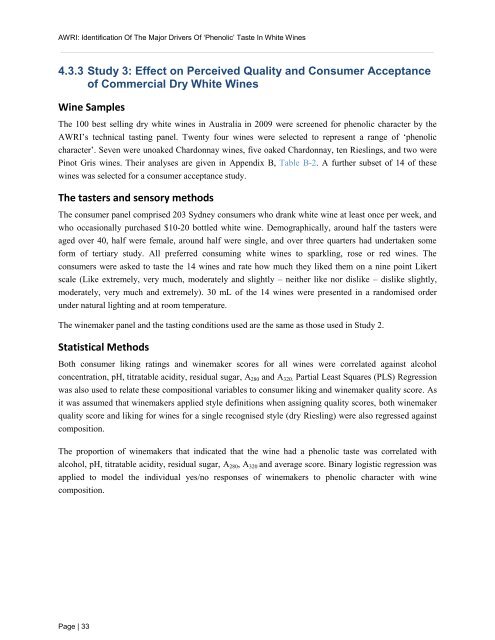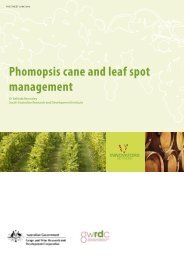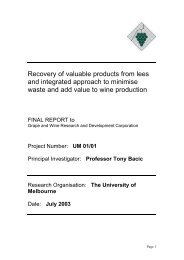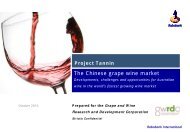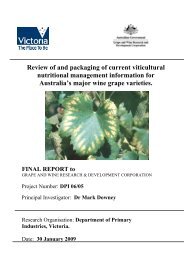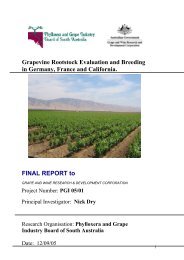Identification of the major drivers of 'phenolic' taste in ... - GWRDC
Identification of the major drivers of 'phenolic' taste in ... - GWRDC
Identification of the major drivers of 'phenolic' taste in ... - GWRDC
You also want an ePaper? Increase the reach of your titles
YUMPU automatically turns print PDFs into web optimized ePapers that Google loves.
AWRI: <strong>Identification</strong> Of The Major Drivers Of ‘Phenolic’ Taste In White W<strong>in</strong>es<br />
4.3.3 Study 3: Effect on Perceived Quality and Consumer Acceptance<br />
<strong>of</strong> Commercial Dry White W<strong>in</strong>es<br />
W<strong>in</strong>e Samples<br />
The 100 best sell<strong>in</strong>g dry white w<strong>in</strong>es <strong>in</strong> Australia <strong>in</strong> 2009 were screened for phenolic character by <strong>the</strong><br />
AWRI’s technical tast<strong>in</strong>g panel. Twenty four w<strong>in</strong>es were selected to represent a range <strong>of</strong> ‘phenolic<br />
character’. Seven were unoaked Chardonnay w<strong>in</strong>es, five oaked Chardonnay, ten Riesl<strong>in</strong>gs, and two were<br />
P<strong>in</strong>ot Gris w<strong>in</strong>es. Their analyses are given <strong>in</strong> Appendix B, Table B-2. A fur<strong>the</strong>r subset <strong>of</strong> 14 <strong>of</strong> <strong>the</strong>se<br />
w<strong>in</strong>es was selected for a consumer acceptance study.<br />
The <strong>taste</strong>rs and sensory methods<br />
The consumer panel comprised 203 Sydney consumers who drank white w<strong>in</strong>e at least once per week, and<br />
who occasionally purchased $10-20 bottled white w<strong>in</strong>e. Demographically, around half <strong>the</strong> <strong>taste</strong>rs were<br />
aged over 40, half were female, around half were s<strong>in</strong>gle, and over three quarters had undertaken some<br />
form <strong>of</strong> tertiary study. All preferred consum<strong>in</strong>g white w<strong>in</strong>es to sparkl<strong>in</strong>g, rose or red w<strong>in</strong>es. The<br />
consumers were asked to <strong>taste</strong> <strong>the</strong> 14 w<strong>in</strong>es and rate how much <strong>the</strong>y liked <strong>the</strong>m on a n<strong>in</strong>e po<strong>in</strong>t Likert<br />
scale (Like extremely, very much, moderately and slightly – nei<strong>the</strong>r like nor dislike – dislike slightly,<br />
moderately, very much and extremely). 30 mL <strong>of</strong> <strong>the</strong> 14 w<strong>in</strong>es were presented <strong>in</strong> a randomised order<br />
under natural light<strong>in</strong>g and at room temperature.<br />
The w<strong>in</strong>emaker panel and <strong>the</strong> tast<strong>in</strong>g conditions used are <strong>the</strong> same as those used <strong>in</strong> Study 2.<br />
Statistical Methods<br />
Both consumer lik<strong>in</strong>g rat<strong>in</strong>gs and w<strong>in</strong>emaker scores for all w<strong>in</strong>es were correlated aga<strong>in</strong>st alcohol<br />
concentration, pH, titratable acidity, residual sugar, A280 and A320. Partial Least Squares (PLS) Regression<br />
was also used to relate <strong>the</strong>se compositional variables to consumer lik<strong>in</strong>g and w<strong>in</strong>emaker quality score. As<br />
it was assumed that w<strong>in</strong>emakers applied style def<strong>in</strong>itions when assign<strong>in</strong>g quality scores, both w<strong>in</strong>emaker<br />
quality score and lik<strong>in</strong>g for w<strong>in</strong>es for a s<strong>in</strong>gle recognised style (dry Riesl<strong>in</strong>g) were also regressed aga<strong>in</strong>st<br />
composition.<br />
The proportion <strong>of</strong> w<strong>in</strong>emakers that <strong>in</strong>dicated that <strong>the</strong> w<strong>in</strong>e had a phenolic <strong>taste</strong> was correlated with<br />
alcohol, pH, titratable acidity, residual sugar, A280, A320 and average score. B<strong>in</strong>ary logistic regression was<br />
applied to model <strong>the</strong> <strong>in</strong>dividual yes/no responses <strong>of</strong> w<strong>in</strong>emakers to phenolic character with w<strong>in</strong>e<br />
composition.<br />
Page | 33


